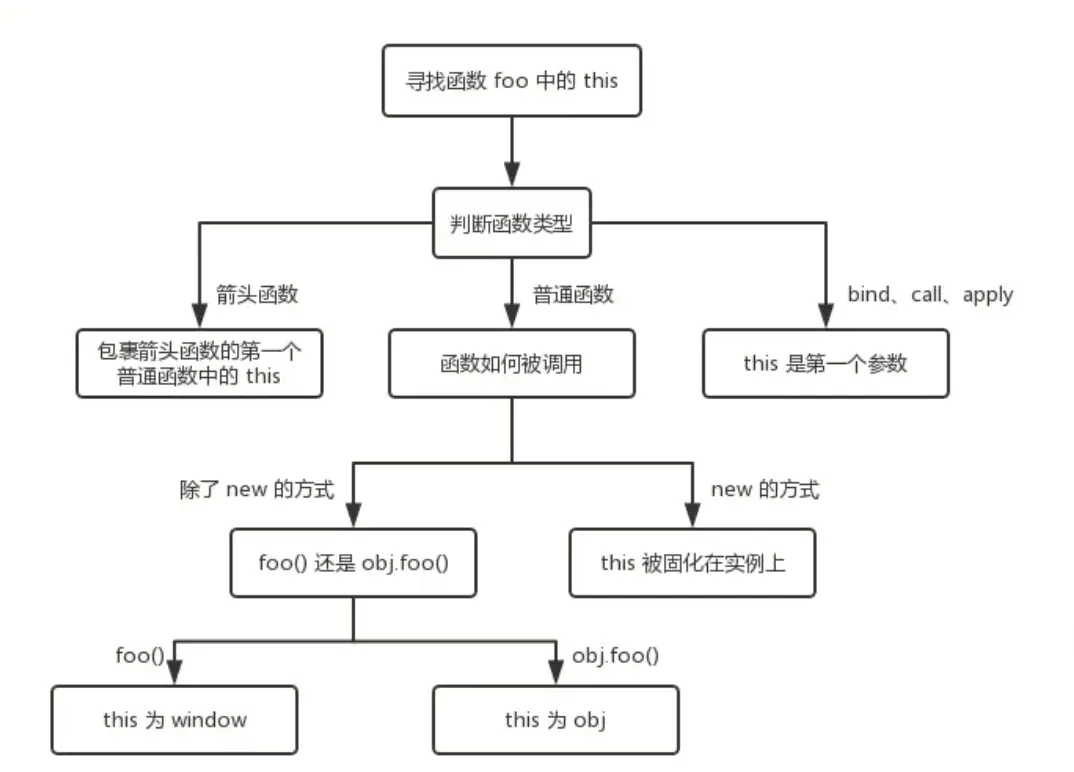# this

- this的绑定在创建执行上下文时确定。
- 大多数情况函数调用的方式决定this的值,this在执行时无法赋值。
- this的值为当前执行的环境对象,非严格下总是指向一个对象,严格下可以是任何值。
- 全局环境下this始终指向window,严格模式下函数的调用没有明确调用对象的情况下,函数内部this指向undefined,非严格下指向window。
- 箭头函数的this永远指向创建当前词法环境时的this。
- 作为构造函数时,函数中的this指向实例对象。
- this的绑定只受最靠近调用它的成员的引用。
- 执行上下文在被执行的时候才会创建,创建执行上下文时才会绑定this,所以this的指向永远是在执行时确定。
function foo() {
console.dir(this); // window, 严格下undefined
}
foo();
-------------------------------
function foo() {
console.dir(this); // 非严格Number对象,严格模式 5
}
foo.call(5);
# 普通函数中的this
# 直接调用
在没有明确调用者情况下函数内部this指向window,严格模式下都为undefined,除非绑定函数的this指向,才会改变this。
// 直接调用函数
function foo() {
console.dir(this); // window 严格下 undefined
function boo() {
console.dir(this); // window 严格下 undefined
}
boo();
}
-------------------------------------
// 取出对象中的函数,再进行调用
const obj = {
foo: function foo() {
console.dir(this); // window 严格下 undefined
function boo() {
console.dir(this); // window 严格下 undefined
}
return boo;
}
}
const foo = obj.foo;
foo()();
--------------------------------------
// 直接通过对象调用函数,再调用返回的函数,可以看出this的指向随调用对象改变
const obj = {
foo: function foo() {
console.dir(this); // obj 严格下 obj
function boo() {
console.dir(this); // window 严格下 undefined
}
return boo;
}
}
const foo = obj.foo();
foo();
--------------------------------------
// 基于回调函数也是如此
function foo(func) {
console.dir(this); // window 严格下 undefined
func();
}
foo(funtion () {
console.dir(this); // window 严格下 undefined
});
# 基于调用者以及不同调用方式
函数调用也就是在函数名后面加个(),表示调用,如果函数名前没有加任何东西,那么默认为简单调用,在严格与非严格环境下,简单调用的函数内部this指向undefined与window,但是全局环境下的this永远为window。
基于对象
当函数作为对象的方法调用时,不受函数定义方式或者位置影响。
// 函数this指向调用者对象
const obj = {
foo: function () {
console.dir(this); // obj1 严格下 obj1
function boo() {
console.dir(this); // window 严格下 undefined
}
boo();
return boo();
}
}
const obj1 = {};
obj1.boo = obj.foo;
obj1.boo();
-----------------------------------------------------
// 不同调用对象时,this指向调用者
const obj = {
foo: function () {
console.dir(this); // obj 严格下 obj
function boo() {
console.dir(this);
}
boo(); // window 严格下 undefined
return boo;
}
}
const obj1 = {};
obj1.boo = obj.boo();
obj1.boo(); // obj1 严格下 obj1
------------------------------------------------------
// this指向最近的调用者
const obj = {
name: 'obj',
obj1: {
name: 'obj1',
foo: function () {
console.dir(this.name); // obj1
}
}
}
obj.obj1.foo();
基于new关键字
// 基于new关键字调用的函数内部this指向实例
function foo() {
console.dir(this); // foo 实例
console.log(this instanceof foo); // true
console.log(foo.prototype.isPrototypeOf(this)); // true
that = this;
}
var that;
const f = new foo();
console.log(that === f); // true
-----------------------------------------------------
// 嵌套函数内部this与调用函数所在环境的this无关
function foo() {
console.dir(this); // foo 实例
function boo() {
console.dir(this); // window 严格下 undefined
}
boo();
}
const f = new foo();
基于定时器与微任务
微任务中的简单调用函数this指向window严格下指向undefined,而定时器中的回调函数不管在严格还是非严格环境下this永远指向window,说明一点,调用window对象的方法时,this指向window也就是全局对象,换句话说,简单调用的函数如果属于window本身自带的方法那么这个方法的this指向window。
// 异步任务中简单调用的函数都是进入队列,最后由全局环境调用
const id = setInterval(function () {
console.dir(this); // window 严格下 window
setTimeout(() => {
console.dir(this); // window 严格下 window
clearInterval(id);
});
});
-----------------------------------------
new Promise(function (resolve, reject) {
console.dir(this); // window 严格下 undefined
resolve();
}).then(function (res) {
console.dir(this); // window 严格下 undefined
});
-----------------------------------------
(async function foo() {
function boo() {
console.dir(this); // window 严格下 undefined
}
await boo();
console.dir(this); window 严格下 undefined
})();
-----------------------------------------
// 定时器的回调最终都会被作为简单函数被执行,定时器属于window对象的方法
function foo() {
setTimeout(function (){
console.log(this); // window 严格下window
});
}
foo.call(5);
------------------------------------------
// 函数内部的this就是指向调用者,并且可以看出简单调用的回调函数中的this也指向window
const obj = {
foo(callback) {
callback();
console.log(this.foo === obj.foo); // true
console.log(this === obj); // true
}
}
obj.foo(function () {
console.log(this); // window 严格下undefined
});
--------------------------------------------
// 通过arguments调用的回调函数中的this指向调用者,注意严格与非严格下的arguments对象有所不同
const obj = {
foo(callback) {
arguments[0]();
console.log(this.foo === obj.foo); // true
console.log(this === obj); // true
}
};
obj.foo(function () {
console.log(this); // arguments 对象 严格下 arguments 对象
});
# 箭头函数中的this
es6引入的箭头函数,是不具有this绑定,不过在其函数体中可以使用this,而这个this指向的是箭头函数当前所处的词法环境中的this对象,可以理解为,this在箭头函数中是透明的,箭头函数包不住this,所以函数内部与外部的this为同一值。
判断箭头函数的this指向,可以把箭头函数看成透明,其上下文中的this就是它的this。
// 可以看出箭头函数中的this就是其所在环境的this,箭头函数无法固定住this,由其环境决定
const foo = () => {
console.dir(this); // window 严格下 window
};
foo();
-----------------------------------------------------
// 可见对象中的this指向window,箭头函数中的this指向对象中的this。由于只有创建执行上下文才会绑定this指向。
// 而除了全局上下文,只有函数作用域才会创建上下文环境从而绑定this,创建对象不会绑定this,所以还是全局this。
const obj = {
this: this,
foo: () => {
console.dir(this); // window 严格下 window
}
};
console.dir(obj.this); // window 严格下 window
obj.foo();
------------------------------------------------------
// 对象方法内部嵌套箭头函数,则此箭头函数的this属于外部非箭头函数this。
// 当调用obj.foo时foo函数创建的执行上下文中的this绑定对象obj,而箭头函数并不会绑定this。
// 所以其this属于foo下的this,即对象obj。
const obj = {
foo: function () {
return () => {
console.dir(this); // obj 严格下 obj
};
}
};
obj.foo()();
# 如何改变函数的this指向
最简单的方法是通过apply、call、bind来给函数绑定this。
- apply方法中第一个参数为被调用的函数中的this指向,传入你想要绑定的this值即可,第二个参数为被调用函数的参数集合,通常是个数组。
- call与apply方法基本一致,区别在于传入参数形式不同,call传入的参数为可变参数列表,参数按逐个传入。
- bind方法与以上不同的是不会直接调用函数,只是先绑定函数的this,到要使用的时候调用即可,此方法返回一个绑定this与参数之后的新函数,其传入参数形式同call。
- 通过变量保留指定this来达到固定this。
// 通过变量保留父级this,进行对_this变量修改也就达到修改原this的效果
const obj = {
name: 'obj',
foo: function () {
const _this = this;
function boo() {
_this.name = 'OBJ';
console.dir(obj.name); // OBJ
}
return boo;
}
};
obj.foo()();
← 实现继承 apply、call和bind →